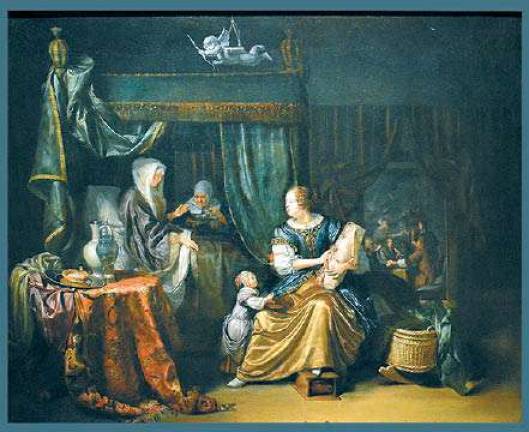Timeless Beauty And A Glimpse of The Past

The Met pairs carpets with their Dutch paintings
If you've been in a gallery of Dutch paintings, chances are you've seen them. Now, the Metropolitan Museum of Art has given them a gallery of their own.
A concise, but fascinating look at the carpets of the near and far east and how they intersected with life in the Netherlands is presented in the exhibition, Carpets of the East in Paintings from the West.
The curators have selected three carpets of specific types and exhibited them side-by-side with three paintings from the Dutch Baroque era. The figures in Bisschop's A Young Woman and a Cavalier stand in front of a table covered with a Lotto carpet just like the Turkish example in the gallery. A "Floral and Cloudband" carpet from the Met's collection matches the one Matthijs Naiveu painted in A Newborn Baby, and Gabriel Metsu's A Musical Party is displayed next to a rare Syrian "Chessboard" carpet similar to the one he chose for his composition.
It's always wonderful to see, in real life and real time, objects depicted in paint by earlier artists, even if they're nothing but old brushes or swatches of fabric. But, the carpets in this exhibition are glorious works of art, and their presentation reminds viewers of that fact.
Sometimes, carefully selected, intimate presentations reward those who visit with just a taste, but a taste that can be savored and lingers.
The exhibition captures, in a small way, a glimpse of the forces that shaped 17th Century Holland, and through it, the world we live in, today. A little more than a century after Columbus journeyed to the east and discovered the west, global trade routes were just beginning to flourish in a serious, commercial way. And Holland--religiously tolerant, when other countries were having inquisitions; scientifically forward, when other countries imprisoned astronomers for proving that the earth wasn't the center of the universe; and wealthy, from promoting openness and trade-was where it was all coming together.
The world's first middle class was emerging. Ship builders and merchants could afford to buy art, previously accessible to only heads of state and churches. They wanted the finest textiles, porcelains, jewels-and rugs. And, they sent ships out to find them and bring them back.
But, they also knew the value of the luxuries they'd worked so hard to acquire, and so, unlike the courts and palaces in Turkey, Persia, China and beyond, in Dutch homes, these carpets were displayed on table tops, not placed on floors to be walked on. Also, if you wanted a fabulous rug, or for that matter, the most prized tulip bulb, or exotic foods from far off lands, but could never hope to afford them, you could always hire a painter to make a picture of them for you-proving your good taste, despite your slender purse. That's the source of all fabulous still life scenes of gorgeous flowers, feasts of champagne and lobsters, and opulent table settings of silver and blown glass we still love to see in Dutch painting.
A visit to Carpets of the East in Paintings from the West, which invites viewers to stop and consider the patterns, colors and geometric shapes of these exotic works, is even more powerful if followed by a stroll through the adjacent galleries. There, Arts of the Loom are more fully explored and displayed in a dazzling group of carpets densely packed with floral motifs. Elegant and evocative, Arts of the Loom brings you into a different time, and takes you out of time, entirely. Surrounded by the elemental and promising shapes of flowers, one realizes why they are so much part of our rites and rituals. They are harbingers of all that is good, and even though they fade quickly, they never die.